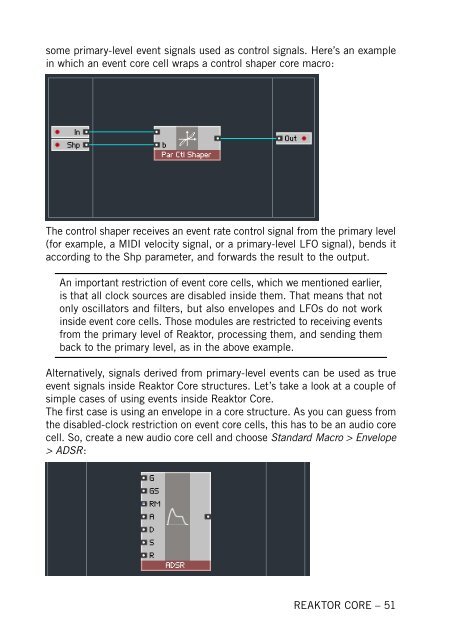1. First steps in Reaktor Core - Native Instruments
1. First steps in Reaktor Core - Native Instruments
1. First steps in Reaktor Core - Native Instruments
Create successful ePaper yourself
Turn your PDF publications into a flip-book with our unique Google optimized e-Paper software.
some primary-level event signals used as control signals. Here’s an example<br />
<strong>in</strong> which an event core cell wraps a control shaper core macro:<br />
The control shaper receives an event rate control signal from the primary level<br />
(for example, a MIDI velocity signal, or a primary-level LFO signal), bends it<br />
accord<strong>in</strong>g to the Shp parameter, and forwards the result to the output.<br />
An important restriction of event core cells, which we mentioned earlier,<br />
is that all clock sources are disabled <strong>in</strong>side them. That means that not<br />
only oscillators and filters, but also envelopes and LFOs do not work<br />
<strong>in</strong>side event core cells. Those modules are restricted to receiv<strong>in</strong>g events<br />
from the primary level of <strong>Reaktor</strong>, process<strong>in</strong>g them, and send<strong>in</strong>g them<br />
back to the primary level, as <strong>in</strong> the above example.<br />
Alternatively, signals derived from primary-level events can be used as true<br />
event signals <strong>in</strong>side <strong>Reaktor</strong> <strong>Core</strong> structures. Let’s take a look at a couple of<br />
simple cases of us<strong>in</strong>g events <strong>in</strong>side <strong>Reaktor</strong> <strong>Core</strong>.<br />
The first case is us<strong>in</strong>g an envelope <strong>in</strong> a core structure. As you can guess from<br />
the disabled-clock restriction on event core cells, this has to be an audio core<br />
cell. So, create a new audio core cell and choose Standard Macro > Envelope<br />
> ADSR:<br />
REAKTOR CORE – 51










